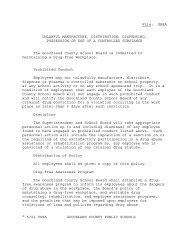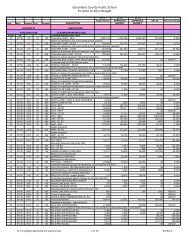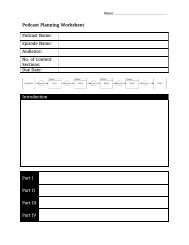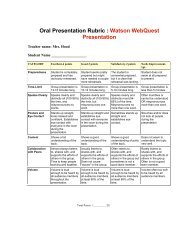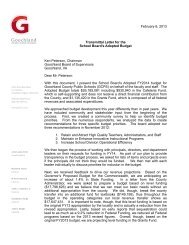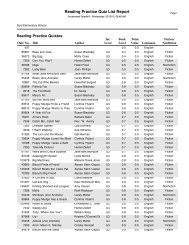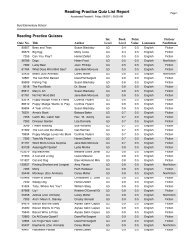Ratiocination A Systematic Approach to Revision
Ratiocination A Systematic Approach to Revision
Ratiocination A Systematic Approach to Revision
You also want an ePaper? Increase the reach of your titles
YUMPU automatically turns print PDFs into web optimized ePapers that Google loves.
<strong>Ratiocination</strong>A <strong>Systematic</strong> <strong>Approach</strong> <strong>to</strong> <strong>Revision</strong>- a logical step-by-step process <strong>to</strong> color-code, analyze, evaluate, and rework yourwriting1) Revising Your Overall Structurea) Check <strong>to</strong> see if your organization makes sense.i) Narration – chronologicalii) Description – spatial(1) side <strong>to</strong> side(2) <strong>to</strong>p <strong>to</strong> bot<strong>to</strong>m(3) front <strong>to</strong> backiii) Persuasion – most important <strong>to</strong> least importantb) Make sure your introduction grabs the reader’s interest and that yourconclusion leaves a lasting impressioni) BAM!(1) question(2) profound statement(3) quoteii) leave them thinkingc) Determine whether you have provided enough support for your main idea.i) Strategy(1) color-coding for main point(a) red pencil – underline the sentence or sentences that conveythe main idea(b) blue pencil – underline the support for main idea(i) details1. facts(ii) examples(iii) incidents(2) not enough blue?(a) Add more facts, details, examples(b) Consider whether all the passages are necessary
2) Revising You Paragraphsa) Check <strong>to</strong> see that each paragraph focuses on a single aspect of the mainidea.b) Eliminate any sentences that are not clearly related.c) Look for places where transitions can help connect ideas.d) Strategyi) Steps – narration/direction/process(1) transitions <strong>to</strong> make sequence clear(a) first(b) then(c) finallyii) Stacks – persuasion(1) transitions(a) in addition(b) as well as(c) most importantiii) Chains – cause and effect(1) transitions <strong>to</strong> clarify relationship(a) consequently(b) as a resultiv) Balances – contrast/choice(1) transitions(a) similarly(b) however(c) although(d) rather3) Revising Your Sentencesa) Check for varied length and structure.i) Compoundii) Complexiii) Simpleb) Strategyi) Colored Pen(1) bracket the first three words of each sentence(2) focus only on bracketed words(3) rework any repetitious phrases for variety
4) Revising Your Word Choicea) Replace vague or general words with vivid, precise onesb) Check for overuse of certain wordsi) Strategy(1) Highlighter(a) Use a highlighter <strong>to</strong> mark any word you have used more thanonce(b) Use a thesaurus <strong>to</strong> choose different words5) Peer <strong>Revision</strong>a) Read writer’s paper out loud.i) Read as written(1) pause at commas(2) s<strong>to</strong>p at periods(3) in<strong>to</strong>ne on questionsii) Listen <strong>to</strong> your partner read your paper.b) Questions for Evaluationi) Is the writing interesting? Does it keep your attention?ii) Can you identify the main idea or theme?iii) Are there enough details <strong>to</strong> support the main idea?iv) Is it organized in the correct way?v) Is all the information relevant <strong>to</strong> the main idea?c) Strategiesi) Remember <strong>to</strong> comment on what is good!ii) Focus on the content, organization and style.(1) leave the mechanics and grammar for lateriii) Make suggestions on how writer can improve the writing.6) Focus on Proofreadinga) Find and eliminate errors in spelling, grammar, usage and mechanicsb) Scrutinize spellingi) Use a dictionary if unsurec) Correct capitalization and punctuation.d) Eliminate run-on sentences and fragments.



